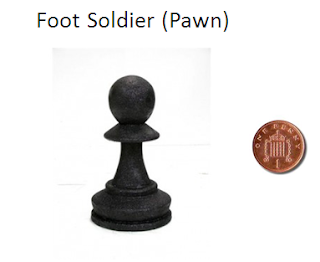Plague
A piece is picked randomly using cards or secretly by yourself to be plagued. When apiece kills it - it is also killed too.
Zombie
The idea here is that a killed piece turns into a zombie (of the same piece type - ie - a killed bishop becomes a zombie bishop). Zombie pieces can not be killed by normal pieces and normal pieces also cannot jump over zombies. Similarly - zombies cannot jump over anything and cannot kill normal pieces. They are a bit like dead weight and clutter on the board - however, if you have more than one zombie piece - you can use one to kill another one of your zombies - which actually reincarnates it as a normal piece again!!(alternatively you could think of ZOMBIES as "Captured" pieces - - so rather than any piece being "killed" they are "captured" - ready to be freed by a fellow captor). NOTE: The zombie piece is placed on the square the normal piece was captured as soon as the capturing piece leaves on their next turn. Similarly, the reincarnated piece is placed on the same square the zombie was captured when the capturing zombie leaves the square.
Cowardly King
This is where your King is not really the King and if it is killed or checked it will not matter - the game will go on. Your true king is masquerading as another piece. Or, put another way, one of your other pieces is the King, although it moves as normal, if it is killed then you lose the game!! Yes - your king may even be a pAWN! -- you cannot choose who your King hides as - or it may start to be predictable after you keep choosing the QUeen! It is chosen at random. You may do this by picking a card at random. King=King (yes - it may simply be the correct piece), Queen=QUeen, Jack=Bishop, 10=Rook/Castle, 9=Knight/Horse, 8=eighth pawn, 7=7th pawn, 6=6th pawn, 5=5th pawn, 4=4th pawn, 3=3rd pawn, 2=2nd pawn, Ace=1st pawn - Players should keep their cards till the end so that when the game is over they can verify they did not cheat and change which piece was king half way through.












